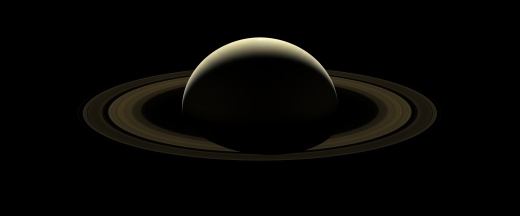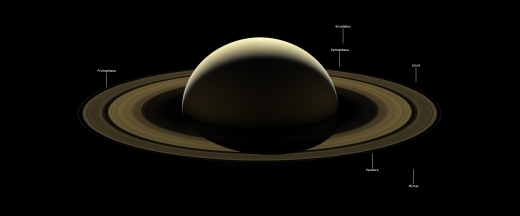Paul Gilster's Blog, page 117
November 30, 2017
Ozone Problematic for Biosignature Detection
TRAPPIST-1 and its seven interesting planets may be the most compelling stellar system we’re investigating, given the range of worlds here and the possibilities for analyzing an entire, nearby planetary system. But as we look toward examining systems like this with new space- and ground-based instruments, we may run into problems with searching for biosignatures. Both the TRAPPIST-1 planets and the promising Proxima Centauri b may be tough to characterize.
The problem: When searching for biosignatures, we’re looking for signs of metabolism, gases that are continually produced and remain out of balance in a planetary atmosphere. Ozone is one piece of the puzzle, one that signifies oxygen. Finding the latter in the same atmosphere with methane would be a compelling biosignature. But ozone could be hard to detect.
Ludmila Carone (Max Planck Institute for Astronomy) and colleagues now find that atmospheric circulation in planets close enough to red dwarfs to be in their habitable zone may mask the very signs we’re looking for. Ozone may become undetectable, trapped in equatorial regions.
The issue involves atmospheric flows, which will likely differ from what we see on Earth. The ozone in our stratosphere is formed when ultraviolet light from the Sun triggers chemical reactions in the oxygen molecules that make up approximately one-fifth of our atmosphere. The ozone protects us from harmful ultraviolet radiation from the Sun, and is distributed throughout the atmosphere owing to large-scale air flows moving from the equatorial regions to the poles.
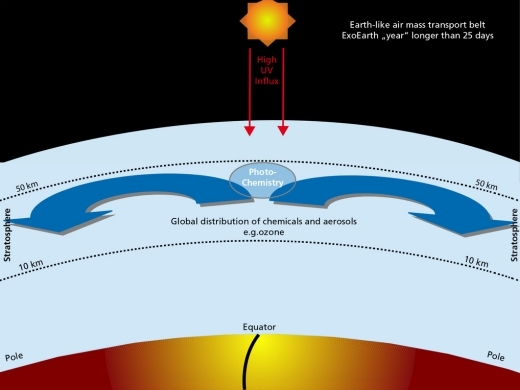
Image: Earth’s atmosphere has a “transportation belt” of air flows which move ozone from the main production areas near the equator towards the poles. This mechanism is important for creating Earth’s global ozone layer. Credit: MPIA (L. Carone & Graphics Dept.)
The problem for exoplanetology is that red dwarf planets in orbits of less than 25 days may be tidally locked to their star, presenting the same face to it at all times. Tidal lock, which we’ve examined often in these pages, could conceivably still allow enough heat to circulate to avoid the kind of extremes between dark and light sides that could prevent life from emerging. But for planets like these, Carone’s models show major air flows moving in the opposite direction, from the poles to the equator. The ozone we seek, then, could be trapped in the equatorial region.
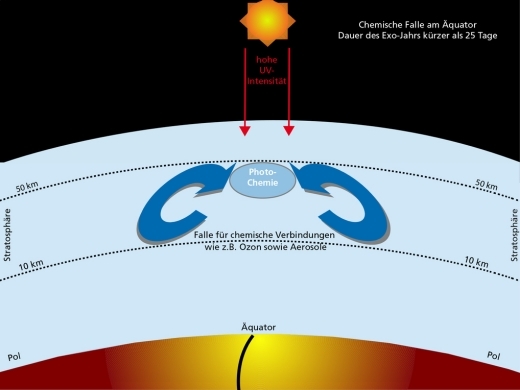
Image: As a new study by Ludmila Carone shows, certain exoplanets could have air flows that serve to trap ozone in the equatorial regions. This could present an unforeseen complication for the search for traces of life on these planets. For those who don’t speak German — my apologies, but I only have this image with German annotation. Credit: MPIA (L. Carone & Graphics Dept.)
This possibility is one we’ll need to consider as we begin the analysis of atmospheres on terrestrial-class planets around nearby red dwarfs. We may find no ozone on planets where ozone and oxygen might actually exist, though sequestered in places that might be difficult to detect. That’s a reverse take on the usual ‘false positive’ problem we’ve discussed here before, with abundant oxygen, for example, not necessarily being a marker for biological activity.
On the other hand, it’s worth asking whether a planet with ozone only in its equatorial regions would be capable of developing life in the first place. On that score, Carrone has an answer:
“In principle: yes. Proxima b and TRAPPIST-1d orbit red dwarfs, reddish stars that emit very little harmful UV-light to begin with. On the other hand, these stars can be very temperamental, and prone to violent outbursts of harmful radiation including UV. There is still a lot that we don’t know about these red dwarf stars. But I’m confident we will know much more in five years.”
True enough, assuming a successful launch of instruments like the James Webb Space Telescope, and the gradual emergence of the next generation of ground-based instruments. But as a marker for oxygen and potential life, exoplanet ozone may be a challenging detection.
The paper is Carone et al., “Stratosphere circulation on tidally locked ExoEarths,” Monthly Notes of the Royal Astronomical Society Vol. 473, Issue 4, pp. 4672-4685 (abstract).






November 29, 2017
Thinking About Saturn After Cassini
Several recent news items on Enceladus have me wanting to catch up with mission possibilities and the instruments that will drive them. NASA’s thinking in that direction takes in a remote sensing instrument called SELFI, an acronym standing for Submillimeter Enceladus Life Fundamentals Instrument. The plan here is to examine the chemical composition of the plumes of water vapor and icy particles that are regularly lofted into space from Enceladus’ south pole, in the region we’ve come to know as the ‘tiger stripes.’
Cassini data on the slight wobble in the orbital motion of Enceladus backs up the idea that the ocean beneath its ice is global, a body likely kept liquid by tidal energies as the moon is pulled and squeezed by Saturn in its orbit. The same process is likely the cause of the cracks that allow ocean water to escape into space, from perhaps as many as 100 sites on the surface.

Image: The Cassini spacecraft detected hydrogen in the plume of gas and icy material spraying from Enceladus during its deepest and last dive through the plume on Oct. 28, 2015. This graphic illustrates a theory on how water interacts with rock at the bottom of the moon’s ocean, producing hydrogen gas. A Goddard team wants to develop an instrument that would reveal even more details about the hydrothermal vents and perhaps help answer if life exists on this ocean world. Credit: NASA/JPL-Caltech/Southwest Research Institute.
Gordon Chin (NASA GSFC), principal investigator for SELFI, describes it as a significant improvement over current submillimeter-wavelength technologies. Says Chin:
“Submillimeter wavelengths, which are in the range of very high-frequency radio, give us a way to measure the quantity of many different kinds of molecules in a cold gas. We can scan through all the plumes to see what’s coming out from Enceladus. Water vapor and other molecules can reveal some of the ocean’s chemistry and guide a spacecraft onto the best path to fly through the plumes to make other measurements directly.”
The GSFC team is using NASA R&D funding to increase the spectrometer’s sensitivity in the 557 GHz range, where the strongest signal from water is to be found. The goal is to explore the entire system of surface vents on Enceladus, measuring water and traces of other gases. The work also includes creating a radio frequency data-processing system, and a digital spectrometer for the RF signal that will convert it into digital signals to allow the measurement of the gases emerging from the plumes in terms of their quantity, temperature and velocity.
Calling it “one of the most ambitious submillimeter instruments ever built,” Chin says in this NASA overview that SELFI should be able to detect and analyze 13 molecular species, ranging from water in various isotopic forms to methanol, ammonia, ozone, hydrogen peroxide, sulfur dioxide, and sodium chloride. Work on the instrument is sufficiently encouraging that the GSFC team believes SELFI will eventually be part of a proposal for a future mission to Saturn.
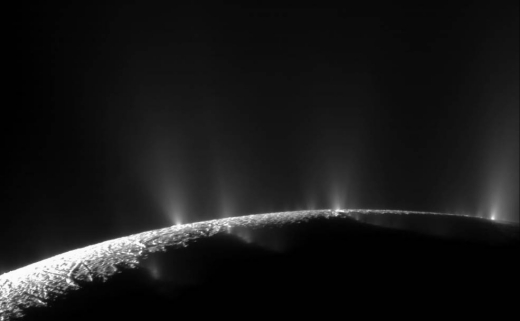
Image: Dramatic jets of ice, water vapor and organic compounds spray from the south pole of Saturn’s moon Enceladus in this image captured by NASA’s Cassini spacecraft in November 2009. Credit: NASA/JPL-Caltech/Space Science Institute.
Assuming it flies, the instrument should allow us to deduce the composition of the global ocean, and its potential for hosting extraterrestrial life. We have no idea whether Enceladus has warm hydrothermal vents of the sort that sustain life at the bottom of Earth’s ocean, but the prospect is enticing not only for this moon but for many of the other icy moons in the outer Solar System.
Into Saturn’s Depths
On the subject of Saturn, be aware as well of an interesting mission possibility called Hera, proposed as an M-class mission led by the European Space Agency, with collaboration from NASA (thanks Mike Fidler for the tip). The plan here is to detach an atmospheric probe from a ‘carrier-relay’ spacecraft as it approaches Saturn, letting the Hera probe enter Saturn’s atmosphere to study its tropopause, descending to pressure levels of at least 10 bars.
From the proposal page:
The primary science objectives will be addressed by an atmospheric entry probe that would descend under parachute and carry out in situ measurements beginning in the stratosphere to help characterize the location and properties of the tropopause, and continue into the troposphere to pressures of at least 10 bars. All of the science objectives, except for the abundance of oxygen, which may be only addressed indirectly via observations of species whose abundances are tied to the abundance of water, can be achieved by reaching 10 bars.

The Hera proposal recalls two previous missions, the first being the Galileo probe that was carried aboard the main Galileo spacecraft to Jupiter, entering the Jovian atmosphere on December 7, 1995 and continuing to function for close to an hour as it descended. The other analog is, of course, Cassini carrying the Huygens probe for the spectacular 2005 landing on Titan. That was a collaboration between ESA and NASA that paid off handsomely, and it provides a model for the carrier/data relay spacecraft model that Hera would use.






November 28, 2017
New Work on Planetary Inflation
Once in space in 2018, the Transiting Exoplanet Survey Satellite (TESS) will be observing, among many other things, hundreds of thousands of red giant stars across the entire sky. Planets around red giants are an interesting topic, because such stars point to an evolutionary outcome our own Sun will share, and we’d like to know more about what happens to existing planets in such systems as the host star swells and reddens, engulfing inner worlds.
New work out of the University of Hawaii Institute for Astronomy now examines two ‘hot Jupiters’ around red giants, stellar systems where we see the gas giants swelling up as the result of processes that remain controversial. The inflated size of planets like these can be explained in at least two ways, one of which involves a slowing of the cooling in the planet’s atmosphere, which causes the planet to inflate soon after formation. But the data presented here, drawn from NASA’s K2 mission, tend to corroborate the thinking of co-author Eric Lopez (NASA GSFC) that direct energy input from the host star is the dominant cause of this planetary inflation.
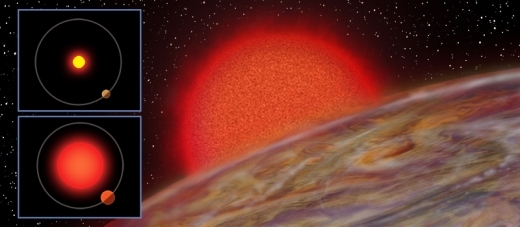
Image: Upper left: Schematic of the K2-132 system on the main sequence.
Lower left: Schematic of the K2-132 system now. The host star has become redder and larger, irradiating the planet more and thus causing it to expand. Sizes not to scale. Main panel: Gas giant planet K2-132b expands as its host star evolves into a red giant. The energy from the host star is transferred from the planet’s surface to its deep interior, causing turbulence and deep mixing in the planetary atmosphere. The planet orbits its star every 9 days and is located about 2000 light years away from us in the constellation Virgo. Credit: Karen Teramura, UH IfA.
The work is now available in The Astronomical Journal, where lead author Samuel Grunblatt and team show that each of the two planets is about 30 percent larger than Jupiter, though in each case only about half as massive. The two planets — K2-132b and K2-97b — are similar in orbital periods, radii and masses. Each orbits its red giant star in about nine days, with planetary radii being calculated at 1.31 ± 0.11 RJ and 1.30 ± 0.07 RJ respectively.
The researchers used models to analyze the evolution of planets like these over time, determining that their radii are typical for planets receiving their current level of radiation, but calculating back to main sequence values of radiation, they find the gas giants would have been considerably smaller. Stellar flux flowing to the planets’ deep convective interiors could therefore explain their current size, an indication that planet ‘inflation’ is directly tied to stellar irradiation rather than delayed atmospheric cooling after the planets’ formation.
But other factors remain to be tested, metallicity in particular. From the paper:
Further studies of planets around evolved stars are essential to confirm the planet re-inflation hypothesis. Planets may be inflated by methods that are more strongly dependent on other factors such as atmospheric metallicity than incident flux. An inflated planet on a 20 day orbit around a giant star would have been definitively outside the inflated planet regime when its host star was on the main sequence, and thus finding such a planet could more definitively test the re-inflation hypothesis. Similarly, a similar planet at a similar orbital period around a more evolved star will be inflated to a higher degree (assuming a constant heating efficiency for all planets). Thus, discovering such a planet would provide more conclusive evidence regarding these phenomena.
Also in play is the issue of heating efficiency, which may well vary between planets depending on their composition. Back to TESS, whose investigations should complement these results. Grunblatt and team point out that TESS should be able to observe additional planets in roughly 10 day orbits around more evolved stars, including oscillating red giants. The data should allow us to distinguish between the delayed cooling possibility and stellar irradiation scenarios.
The paper is Grunblatt et al., “Seeing Double with K2: Testing Re-inflation with Two Remarkably Similar Planets around Red Giant Branch Stars,” Astronomical Journal Vol. 154, No. 6 (27 November 2017). Abstract / preprint.






November 27, 2017
Cassini’s Exquisite Last View
The release of Cassini’s last images of Saturn and its rings is a welcome event, a capstone to the mission that has taught us so much. What we see below is a series of images that have been grafted together, 42 red, green and blue images that allow us to see a wide-angle mosaic of Cassini’s view. The images were taken by the spacecraft’s wide-angle camera on September 13, and include the moons Prometheus, Pandora, Janus, Epimetheus, Mimas and Enceladus.
Image: After more than 13 years at Saturn, and with its fate sealed, NASA’s Cassini spacecraft bid farewell to the Saturnian system by firing the shutters of its wide-angle camera and capturing this last, full mosaic of Saturn and its rings two days before the spacecraft’s dramatic plunge into the planet’s atmosphere. During the observation, a total of 80 wide-angle images were acquired in just over two hours. This view is constructed from 42 of those wide-angle shots, taken using the red, green and blue spectral filters, combined and mosaicked together to create a natural-color view. Credit: NASA/JPL-Caltech/SSI.
I was glad to see some Cassini team members reminiscing about Voyager, whose journeys opened up the outer Solar System to close view, and continue to inform us about the interstellar medium. Thus Carolyn Porco, former Voyager imaging team member and Cassini’s imaging team leader at the Space Science Institute in Boulder, Colorado:
“For 37 years, Voyager 1’s last view of Saturn has been, for me, one of the most evocative images ever taken in the exploration of the solar system. In a similar vein, this ‘Farewell to Saturn’ will forevermore serve as a reminder of the dramatic conclusion to that wondrous time humankind spent in intimate study of our Sun’s most iconic planetary system.”
Here is a brightened view, processed to bring out detail in the fainter areas of the image. The six moons mentioned above show up faintly, but the annotations should help.
Image: The ice-covered moon Enceladus — home to a global subsurface ocean that erupts into space — can be seen at the 1 o’clock position. Directly below Enceladus, just outside the F ring (the thin, farthest ring from the planet seen in this image) lies the small moon Epimetheus. Following the F ring clock-wise from Epimetheus, the next moon seen is Janus. At about the 4:30 position and outward from the F ring is Mimas. Inward of Mimas and still at about the 4:30 position is the F-ring-disrupting moon, Pandora. Moving around to the 10 o’clock position, just inside of the F ring, is the moon Prometheus. Credit: NASA/JPL-Caltech/SSI.
We’re looking toward the sunlit side of the rings from about 15 degrees above the ring plane, with Cassini at approximately 1.1 million kilometers from the planet and on its final approach.
Titan’s Polar Vortex
Although Cassini is gone, we have vast amounts of data that will continue to generate new discoveries for quite some time, as witness the latest, a paper out of the University Of Bristol that discusses the atmospheric chemistry on Saturn’s largest moon, Titan. Lead author Nick Teanby has been studying Titan’s upper atmosphere, where in the polar regions we are seeing unexpected cooling, a process that differs from what we see on Earth, Venus and Mars.
Indeed, Titan’s polar vortex seems to be extremely cold. What we see on the other worlds is that the high altitude polar atmosphere on a planet’s winter hemisphere is warmed as a result of sinking air heating as it is compressed. It was Cassini’s Composite Infrared Spectrometer (CIRS) instrument that produced the observations Teanby has used to study this anomaly on Titan.
CIRS data showed the expected polar hot-spot beginning to develop in 2009, but temperatures dropped significantly by 2012 and remained as low as 120 K until late 2015, after which the expected hot-spot returned. Teanby explains what’s happening this way:
“For the Earth, Venus, and Mars, the main atmospheric cooling mechanism is infrared radiation emitted by the trace gas CO2 and because CO2 has a long atmospheric lifetime it is well mixed at all atmospheric levels and is hardly affected by atmospheric circulation. However, on Titan, exotic photochemical reactions in the atmosphere produce hydrocarbons such as ethane and acetylene, and nitriles including hydrogen cyanide and cyanoacetylene, which provide the bulk of the cooling.”
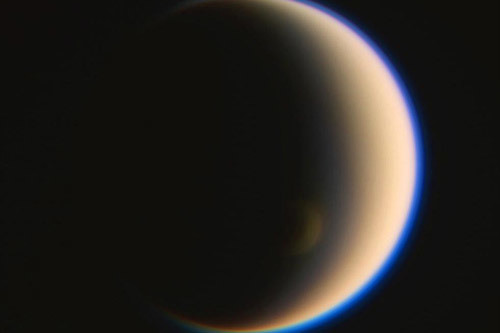
Image: Titan’s winter polar vortex imaged by the Cassini Spacecraft’s ISS camera. The vortex is now in deep winter and can only be seen because the polar clouds within the vortex extend high above Titan’s surface into the sunlight. The vortex was extremely cold from 2012-2015, giving rise to unusual nitrile ice clouds. Credit: NASA/JPL-Caltech/Space Science Institute/Jason Major.
Hydrocarbons and nitriles appear high in the atmosphere and are strongly susceptible to vertical atmospheric circulation, meaning that over the southern winter they accumulate in great amounts over the pole, creating the cooling Teanby and team are studying. The work also draws on Cassini data from 2014, when hydrogen cyanide ice clouds were observed over the pole, a reminder not only of Titan’s intriguing chemistry but the continuing vitality of Cassini data.
The paper is Teanby et al., “The formation and evolution of Titan’s winter polar vortex,” published online by Nature Communications 21 November 2017 (full text).






November 25, 2017
A Thought for the Weekend
From Arthur C. Clarke’s Interplanetary Flight: An Introduction to Astronautics (London: Temple Press Limited, 1960):
There is no way back into the past; the choice, as Wells once said, is the universe–or nothing. Though men and civilizations may yearn for rest, for the dream of the lotus-eaters, that is a desire that merges imperceptibly into death. The challenge of the great spaces between the worlds is a stupendous one; but if we fail to meet it, the story of our race will be drawing to its close.

November 24, 2017
Email Delivery Problems
Several readers have told me that their email deliveries of Centauri Dreams have not been coming through. This has been an on-again, off-again problem for some time and I’m now trying to switch providers to take care of it. Bear with me, as I hope to have the problem resolved within a few days.

Shards, Axis Ratios and Interstellar Objects

It being the day after the Thanksgiving holiday here in the States, I hadn’t planned a post, but a few more things have cropped up about ‘Oumuamua that I can quickly tuck in here. Now that I’ve learned how to pronounce it (oh MOO-uh MOO-uh), it doesn’t seem nearly as intimidating — it’s the lineup of vowels that trips up the unwary. On the other hand, Jim Benford suggested on Wednesday that we avoid the vowels altogether and call this thing ‘the Shard.’
Here’s the photo Jim sent of the Shard, a 95-story London skyscraper sometimes called The Shard of Glass. It’s 309.7 metres high, the tallest building in the United Kingdom, featuring 11,000 panes of glass with a total surface area of 56,000 square metres. What draws Jim’s attention is the 6 to 1 aspect ratio, with ‘Oumuamua’s thought to be 10 to 1. Jim might also have referenced London’s BT Tower (8 to 1), but what the Guinness Book of World Records calls the “most slender tower” turns out to be the i360 observation tower in Brighton, at a whopping 41 to 1.

With ‘Oumuamua, though, we now have to ask whether the 10 to 1 ratio is actually correct, as Jason Wright noted in a recent post. The problem here is that, unlike the situation with Boyajian’s Star, we have a small dataset to work with, and according to Wright (Penn State), researchers are getting different aspect ratios, ranging all the way from the aforementioned 10 to 1 down to a relatively ordinary 3 to 1.
If the latter is the case, the interstellar object may look something more like Haumea than the Shard. “I’ll need to see a lot more data and hard, critical analysis of the anomalies in ‘Oumuamua before I get interested in the SETI angle at the level I am for Tabby’s Star,” adds Wright.
Greg Laughlin (UC-Santa Cruz) also weighed in on ‘Oumuamua with a new paper (citation below) and accompanying article in Scientific American. Laughlin dubs our visitor “exhilaratingly bizarre” and goes on to describe its unusual arrival, in which, despite accruing 20 kilowatts of energy per square meter at perihelion, it showed no evidence of cometary activity. It was fun to see that Greg also refers to ‘Oumuamua at one point as “a crazily elongated shard.”
But what drew my attention in Greg’s post was how difficult the ejection of debris from a newly forming planetary system seems to be. Getting such a shard free from the host star demands a gravitational assist from a massive planet located at a large distance from the star — terrestrial worlds in our Solar System would fall far short, though the gas giants could manage the feat.
If objects like ‘Oumuamua are common and if they are made predominantly of ice, as we would expect in an outer stellar system, then it implies, says Laughlin, that almost every star in the Milky Way hosts a Neptune-class planet at roughly the distance of our own Neptune from the Sun.
And if it really is rock or metal? Then we deal with another scenario entirely:
…in the highly unlikely event ‘Oumuamua is indeed a refractory slab of rock or metal, as suggested by its complete lack of coma, then its appearance is extremely hard to understand. Only a few percent of stars host planets that are capable of ejecting volatile-free debris from warm regions deep within a gravitational well. They flat-out can’t generate the vast overall swarm implied by ‘Oumuamua’s recent passage, suggesting that another visit by a similar object won’t happen for a very long time.
A long time indeed. According to Laughlin’s calculations of that scenario, ‘Oumuamua could travel for 10 quadrillion years before coming into similar proximity to another star.
At that far distant time, the galaxy will be a very different place, in which all the stars that now shine warmly down on planets will be expired white dwarfs, warmed a few degrees above absolute zero by the flicker of proton decay.
The paper is Laughlin, G. & Batygin, K. (2017) “On the Consequences of the Detection of an Interstellar Asteroid,” submitted to Research Notes of the AAS (abstract).

November 22, 2017
`Oumuamua: Listening To An Interstellar Interloper
The buzz about `Oumuamua, our first known visitor from another stellar system, seems likely to continue given yesterday’s news that the object’s axis ratio is a startling 10 to 1. Given all that, Jim Benford wondered whether there were SETI implications here. Was anyone on the case from our major SETI organizations? The answer is below, as we learn that the effort is ongoing. A frequent contributor to these pages, Jim is President of Microwave Sciences in Lafayette, California, which deals with high power microwave systems from conceptual designs to hardware. He also heads up the critical sail subcommittee for Breakthrough Starshot, the effort to send small beamed sails with miniaturized payloads to a nearby star.
By James Benford

I contacted Jill Tarter and Andrew Siemion about whether SETI researchers are conducting observations of the interstellar interloper, Oumuamua. Both say yes.
Jill said that the Allen Telescope Array has been looking at it for a while. Andrew said that Breakthrough Listen was using the Green Bank Telescope for a few hours last weekend. This was actually looking for water via hydroxyl lines using broadband 1.1-1.9 GHz data. No water was immediately evident in the coarse spectra from the standard data reduction. Breakthrough Listen is working on incorporating the appropriate windowing capabilities necessary to analyze this data, so as to use their data analysis pipeline.
Therefore there are some observations in parts of the microwave spectrum.
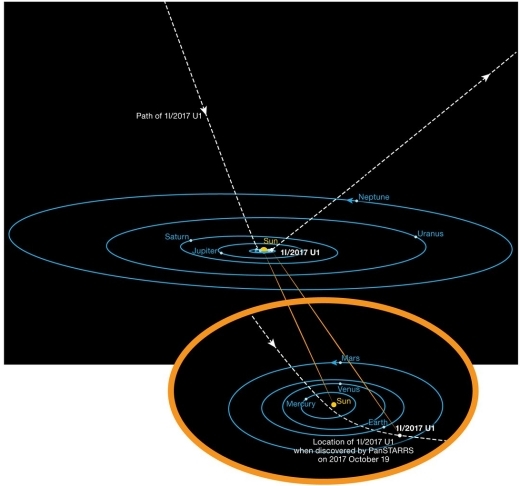
Image: This diagram shows the orbit of the interstellar asteroid ‘Oumuamua as it passes through the Solar System. Unlike all other asteroids and comets observed before, this body is not bound by gravity to the Sun. It has come from interstellar space and will return there after its brief encounter with our star system. Its hyperbolic orbit is highly inclined and it does not appear to have come close to any other Solar System body on its way in. Credit: ESO/K. Meech et al.
Besides astronomical observations of this unique object, there is also this remote possibility: That this interloper is an interstellar survey probe, having perhaps dropped down to interplanetary-scale velocities in order to take data during its transit of our solar system, before going on to another star.
If this is the case, then perhaps we ought to be looking rather broadly in the electromagnetic spectrum for any signal it might send to us, having easily detected leakage from Earth. That assumes it would try to respond to us using frequencies it knows we use. That would certainly include the microwave bands 1-10 GHz, where most of our radiation leakage radiation is.
I think at present the frequencies most observable coming from Earth are leakage of uplink transmissions to our satellites, of which there are now about 1200 active in orbit. Those frequencies tend to be in the upper end of the microwave where the wavelength is smaller, so we can use smaller apertures on both Earth and satellite. Downlinks, of course, would be absorbed in the Earth and not observable from afar.
Or, because they know enough about our atmosphere’s transmission windows and the Sun’s radiation spectrum, they might be signaling in the visible. Therefore our SETI optical observatories ought to be watching as well.
I would look for a pulsed beacon signal, which is more noticeable. That would be like a pulsar, but of course with no interstellar dispersion.
This matter has a very low probability of success, of course. However, it’s our first opportunity to observe at close range a truly interstellar object.

Image: This plot shows how the interstellar asteroid `Oumuamua varied in brightness during three days in October 2017. The large range of brightness — about a factor of ten (2.5 magnitudes) — is due to the very elongated shape of this unique object, which rotates every 7.3 hours. The different coloured dots represent measurements through different filters, covering the visible and near-infrared part of the spectrum. The dotted line shows the light curve expected if `Oumuamua were an ellipsoid with a 1:10 aspect ratio, the deviations from this line are probably due to irregularities in the object’s shape or surface albedo. Credit: ESO/K. Meech et al.

November 21, 2017
Unusual Visitor: A Deeper Look at ‘Oumuamua
When I first wrote about the interstellar interloper now called ‘Oumuamua, I made reference to Arthur C. Clarke’s Rendezvous with Rama because of the delightful symmetry between the novel and the object, though noting that ‘we’re unlikely to find that A/2017 U1 is as intriguing as Clarke’s mysterious starship bound for the Magellanics’ (see An Interstellar Visitor?). Still, an interstellar object entering the Solar System only to go careening back out of it could not help but recall Clarke, whose ‘asteroid’ 31/439 wound up being artificial.
Then came the paper from Karen Meech (University of Hawaii Institute for Astronomy, where the object was first detected with the Pan-STARRS1 telescope). Drawing on data from telescopes around the world, Meech’s team has been able to characterize our first nearby object from another stellar system, with equally delightful results. For it turns out that ‘Oumuamua (pronounced oh MOO-uh MOO-uh) has an unusual axis ratio, being about ten times longer than it is wide. Jim Benford couldn’t resist suggesting I show a cover from Rendezvous with Rama depicting just such an axis ratio, and I agreed wholeheartedly.
Any science fiction fan familiar with Clarke (and are there any who aren’t?) will have fun with the similarities, but how much do we actually know about ‘Oumuamua? Meech’s team based its conclusions on the object’s shape on the fact that its brightness changed so dramatically as it rotated (spinning on its axis every 7.3 hours). Lance Benner, who specializes in radar imaging of near-Earth and main-belt asteroids at JPL, calls the axis ratio here ‘truly extraordinary.’ We know of no Solar System objects elongated more than 3 times longer than they are wide.
Nothing in our Solar System, in other words, quite matches an object shaped like this. Of course, it might also look like the image below, courtesy of the European Southern Observatory.
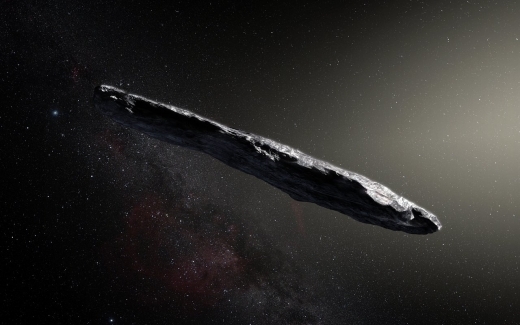
Image: This artist’s impression shows the first detected interstellar asteroid: `Oumuamua. This unique object was discovered on October 19, 2017 by the Pan-STARRS 1 telescope in Hawai`i. Subsequent observations from Gemini, ESO’s Very Large Telescope in Chile, CFHT, UKIRT, and other observatories around the world show that it was on a path which must have been travelling through interstellar space for millions of years before its chance encounter with our star system. `Oumuamua seems to be a dark red highly-elongated metallic or rocky object, about 400 meters long, and is unlike anything normally found in the Solar System. Credit: ESO/M. Kornmesser.
On the other hand, the object’s light curve, as examined through data from the Canada-France-Hawaii Telescope (CFHT), can show us rotation and likely axis ratio, but the overall observations — from the United Kingdom Infrared Telescope (UKIRT), the Keck Telescope on Mauna Kea, the Gemini South telescope, and the European Southern Observatory (ESO) Very Large Telescope (VLT) in Chile as well as CHFT — show similarities with local objects as well as differences. Here’s Karen Meech on those findings:
“While study of `Oumuamua’s colors shows that this body shares characteristics with both Kuiper Belt objects and organic-rich comets and trojan asteroids, its hyperbolic orbit says it comes from far beyond.”
The object’s dark red color is similar to Kuiper Belt objects, and the researchers believe it is dense and rocky or with high metal content, an asteroid that, according to this ESO news release, lacks significant amounts of water or ice, and one whose surface darkening and reddening is the result of millions of years of irradiation. Current length estimates are in the range of 400 meters.
So while its composition is similar to objects in our Solar System, its shape is unique and so, of course, is its origin. Observations of the object had to be quickly compiled, for while it was only 85 times the Earth-Moon distance away when discovery was announced earlier this month, it is moving away rapidly. It was clear to the discoverers that they had little time to gather data on this enigmatic visitor. Thus Gemini director Laura Ferrarese, who applied Gemini South’s resources to the study for Meech’s group: “Needless to say, we dropped everything so we could quickly point the Gemini telescopes at this object immediately after its discovery.”
Both Hubble and Spitzer are also tracking the object the week of November 20, according to JPL. And here’s another science fictional bit: Preliminary orbital calculations show `Oumuamua came from the approximate direction of Vega, in the constellation Lyra. That just might recall Carl Sagan’s novel Contact, where a SETI signal containing data is found to be coming from Vega, 26 light years away, leading to the construction of a most unusual device.
But there the similarities end: Our object is simply traveling too slow to have been sent from Vega, which would not have been nearby when `Oumuamua was there 300,000 years ago.
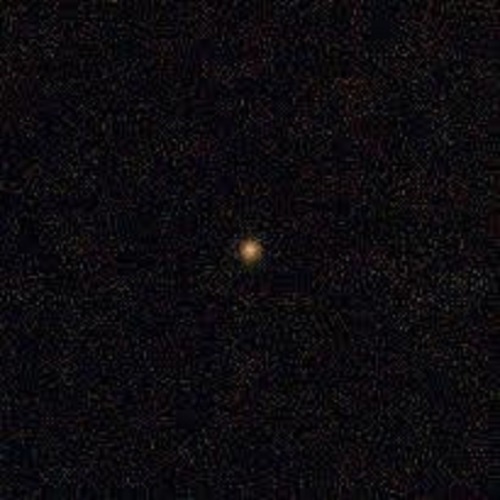
Image: This composite was produced by combining 192 images obtained through three visible and two near-infrared filters totaling 1.6 hours of integration on October 27 at the Gemini South telescope. Processing removes the background stars. The field of view represents a patch of sky 5,000 km on a side at the distance of `Oumuamua. Visible colors for the image were assigned to each filter as follows:
g (398-552 nm) = blue
r (562-692 nm) = green
i (706-850 nm) = yellow
z (830-925 nm) = orange
Y (970-1070 nm) = red
While assigning visible colors to filtered images is somewhat subjective, the resulting color of `Oumuamua in optical light is similar to the hue of some of the moons of outer planets in our Solar System, and possibly indicates a similar composition (a combination of minerals, carbon, iron, and organic compounds). Color composite produced by Travis Rector, University of Alaska Anchorage, using Gemini South GMOS data obtained and processed by Meech et. al. Credit: Gemini Observatory/AURA/NSF
Are we going to find more such visitors? Ejected comets and asteroids, forced into the deep through interactions with larger planets, may be relatively common. In fact, Robert Jedicke, who is part of the team working with Meech, estimates that a similar object, of similar size, is out there between the Earth and the Sun at any given time, up to perhaps 10 every year. If so, it will be surveys like Pan-STARRS and the future Large Synoptic Survey Telescope (LSST) that begin to compile statistics on the frequency of visitors like `Oumuamua.
`Oumuamua is now traveling at 38.3 kilometers per second relative to the Sun, about 200 million kilometers from Earth, and will pass the orbit of Jupiter in May of 2018, headed in the general direction of the constellation Pegasus. We should be able to continue to refine its trajectory as it leaves the Solar System through mid-December, when it becomes too faint to detect.
I am not saying this is going to happen, but wouldn’t it be fascinating if we learned it was headed toward another nearby star…
The paper is Meech et al., “A brief visit from a red and extremely elongated interstellar asteroid,” published online by Nature 20 November 2017 (abstract).

November 17, 2017
Mining Asteroids for Fun and Maybe Profit
Volatiles for propulsion and life support only scratch the surface of what we might extract once viable mining communities begin tapping the asteroids. Metals like platinum remind us how readily available some resources will be in space as opposed to trying to dig them out from the depths of our planet. Centauri Dreams regular Alex Tolley continues to explore these matters in today’s essay, which looks at how companies will turn a profit and what kinds of targets most justify early efforts. Key to our hopes for asteroid mining is reducing the costs of getting payloads into space. That’s a driver for an infrastructure whose demands may well produce the propulsion solutions we’ll need as we push outside the Solar System.
by Alex Tolley
“There’s gold in them thar hills” – M. F. Stephenson

Introduction
In 1848, James Marshall discovered gold at Sutter’s Mill, on the American River, in foothills of the Sierra Nevada mountains of California. The California gold rush ensued. Science fiction stories have been replete with such miners eking out a living in the asteroid belt, hoping for that lucky strike and the discovery of the gold asteroid. While gold is no longer used to back the value of fiat currencies, other metals have arisen to take their place as valuable elements, from platinum to the so-called rare earth elements. John Lewis [5] estimated that the asteroid resources of the solar system vastly exceeded the potential supplies on Earth and that reserves were far more accessible than those deep within the Earth’s crust or even below it.
Despite this, there is not a single mining company currently extracting such vast wealth. One reason is the same as the absence of seabed mining for manganese nodules – the legal position of those resources. Those legal restrictions are now being actively changed as the possibility of being able to mine these bodies becomes more feasible. Yet so far, only startups have formed with distant plans to extract those vast riches.
So assuming that those resources are legally owned by the prospectors, just how viable is the space mining business?
The possible approaches to mining include the classic platinum group metals, Fe-Ni metals, carbon, rocks for radiation shielding, and most recently, volatiles, especially water, for propulsion and life support. The question is what to target, and how to do it profitably.
Approaching the Economics of Financial Return
A business must generate positive value. Traditionally, this is estimated by requiring a positive value for discounted cash flows, where the initial capital cost is recovered by a stream of net cash flows suitably reduced by the required risk-adjusted rate of return.
Sonter [7] derived the equation below as a baseline for determining the net present value of an asteroid mining business.

Figure 1 – the value of a an asteroid mining program.
The Sonter Equation
Sonter’s equation is a nice simplification, although it suffers from some operational assumptions. The terms describe the present value of the material returned to an Earth orbit and the costs associated with that operation. The equation explicitly assumes that the value is the orbital mass value by launch cost, for example for volatiles and commodity metals, but excludes precious metals that could be returned to earth. The mass returned is adjusted by delta V costs for propellant for solar-thermal propulsion, mined concurrently. Mass returned must be 250-500x the mass of the miner to be viable. Higher isp rockets would increase the fraction of mined payload returned to earth orbit. The discounted value is adjusted with a time value based on orbital mechanics, which assumes a one-shot operation of a single vehicle prospecting and returning to Earth orbit. This is decoupled from the number of years of the operation. The mining “season” was assumed to be short compared to the transfer time to and from the asteroid. Launch costs of the mining craft appear to be excluded too, which is a rather major component of the business cost. This might be explained by reference to Oxnevad who, using NASA launch costs believed that launch costs were not a critical issue, although it is now thought that the drive to lower launch costs by the New Space companies does make this a relevant factor.
Sonter assumed that launch costs would decline to at least $200-500/Kg, a cost necessary for developing space assets probably driven by space tourism. Without that driver, there is little need for large mass space infrastructure and asteroid mining would probably be still-born. 1000 MT developments was Sonter’s tipping point for favorable asteroid mining conditions.
Asteroid Targets
The best targets have low delta V and short return intervals. The earth-approaching bodies such as the Apollo, Amor, or Aten asteroids, and possibly Mars’ moons, Phobos and Deimos. Sonter goes into some detail on target selection based on orbits, although also allowing less delta V-favorable dead comets are suitable.
Sonter states as a conclusion:
Thus there will potentially exist a profit-rnaking opportunity for a resource developer who could develop a capability to recover space-based materials and return them for sale in low-Earth orbit to capture the developing in-orbit market at its inception.
Mining for platinum group metals
Let’s start by looking at those more high value elements, the platinum group metals. Platinum is currently priced at around $30k/Kg. But to extract such elements requires handling a lot of asteroidal rock. Even the best concentrations are in the tens of parts per million (ppm), although higher concentrations may be found.
Gerlach [4] published work on his NEOMiner – a fairly extensive analysis of a large mining craft that would extract platinum group metals [PGM]. The craft was to be about 4.5 MT in size and return 14-35 MT of platinum using a chemical extraction method. The cost of the craft was to be around $150MM
Ross [6] looked at various mining options, and estimated that the craft must return more than 100x its mass in valuable resources.
Andrews [1] also went big, with a plan returning $10s bn over 12 years, although positive cumulative cash flows were only appearing by year 10, a very long and risky time horizon. The size of the operation required mining 5 million MT of regolith, equivalent to an open cast mine pit 250m in diameter and 125m deep.
Over long time horizons, the business faces forecast risks. In 2003, Gerlach [4] assumed a doubling of the demand for platinum in a decade based on the hyped hydrogen economy and need for platinum in fuel cells. However, platinum demand declined over that period as fuel cells used less platinum, and also switched to cheaper alternatives, a classic economics response that had largely invalidated resource shortage doom-saying in the 1970s. A similar fate befell Dennis Wingo’s [9] hopes for recovering platinum from lunar impact sites.
Mining for Water
The simplest resource to extract from stony and carbonaceous asteroids are volatiles, including water. Unobe [8] showed that common minerals in asteroids might contain water and hydrated minerals up to 25% by mass. Lab experiments on various simulated asteroid materials showed that volatiles, primarily water, could be recovered by heating the rocks up to 800°C and condensing the emitted gases in a cold trap for recovery.
The higher the capital cost, the higher the return risk. This has led to smaller, lower cost, designs for mining craft. At the 2017 IAC meeting, Calla et al [2] described a mining craft mission architecture to extract water using microwave heaters to extract and collect water. Their baseline craft was less than 500 kg. Their targets were NEAs with very low delta Vs, a short season for mining of less than a month while the NEA was close enough (less than 0.1 AU) to be teleoperated from Earth, and the returned payload just 100 kg of water. Total mission time was about 1 year. For simplicity, microwave heating was assumed for extracting the water, with an average of about 8.5% content by mass of suitable asteroids. Mined water was to be used for propulsion, using an off-the-shelf electrolysis unit to separate the gases prior to combustion.
Their particular innovation was to use many copies to reduce unit costs. The R&D costs of a single unit would be amortized, and scale economies would further drive down costs. The value of water delivered to various orbits was simply their launch costs to certain earth orbits by mass.

Figure 2. Cost analysis and economic return for one spacecraft.

Figure 3. Cost analysis and economic return for two hundred and fifty spacecraft.
Figure 2 shows the payback from one spacecraft, and figure 3 shows the payback from 250 craft. For a single craft, profitability is never attained, even for high cost, cis-lunar orbits. With 250 craft, the reduced unit costs allow for profitability when delivering water to cis-lunar space at $35k/Kg. However, breakeven is not for 5 years. Any reduction in transport costs would push out the payback period, perhaps disastrously.
Calla’s analysis failed to learn the lessons from earlier analyses that profitability requires high mass payload multipliers, of 2 orders of magnitude or more. Clearly, the higher the return payload, the larger the craft to deliver mining energy, or the longer the mining operation. By adapting the craft for autonomous operation, the craft could mine for 1 ½ orbits rather than just a 1/10th of an orbit, allowing for at least a 20 to 40x increase in payload.
High demand requires low launch costs = low commodity value
While delivering platinum and other precious metals to earth has been studied, most analyses assume that demand will be in space. Water for propulsion and life support, metals for structures and even regolith as meteor and radiation shielding. As noted earlier, this demand requires much lower costs for access to space, reducing the value of these resources.
Sonter:
“A cost delivered into LEO of probably $200/kg or so will be necessary for space raw materials resources recovery to be a viable competitor against Earth-launch cost in the first few decades of the next century.”
With launch costs to orbit reduced 10-fold, plugging is suitable values to the Sonter equation shows that the value of water return to cis-lunar space becomes negative, only recoverable by a commensurate increase in the returned payload. This implies more powerful mining equipment, higher rates and efficiency of processing material, and more powerful engines to make the return journey. This may become a vicious cycle of adding spacecraft mass and cost, undermining the low cost, low risk, small mining craft approach.
Multiple lines of income?
It has been suggested that multiple lines of revenue might be needed, beyond the returned resources – scientific data and media broadcast rights might help defray the costs. For example, SpaceFab has suggested that scientific information may be more valuable per kg than the resource itself. Media rights are often sold for interesting projects that would attract viewers. The Interplanetary Society’s failed Cosmos solar sail experiment was partially financed in return for media rights. A proposed reality show of [doomed] Mars colonists was a brief sensation a few years ago. These alternative revenue streams might be possible in the early stages of the mining business, but once the business becomes established, the novelty wears off and the value of these revenue streams decline.
The future
A key issue is how to increase demand of space resourced materials by reducing the cost of access to space, while maintaining the relative value of these resources acquired from extraterrestrial bodies. Clearly, one issue is reducing the capital cost of the mining craft. Calla’s use of multiple copies of the craft makes a lot of sense as it leverages the economic drivers of mass production. Coupled with reduced launch costs as currently being pursued by New Space companies, capital costs and financial risks are reduced. The CubeSat approach using off-the-shelf components and software shows the way. Spacecraft need to manufactured like automobiles – scale economies reducing costs, rather than highly expensive, custom vehicles for specific missions. The craft need to use common components and just adapt their equipment for the asteroid type and target resource.
Reduced launch costs are also needed to increase demand. Launch costs of 5-10% of current costs, largely due to launch vehicle reusability are expected to drive increased use of space, of which tourism is a much hoped for business.
As we can see from the Sonter equation, once the NEAs are used up, the higher delta Vs and longer mission times of the main belt asteroids requires better propulsion systems. Ideally, propellantless propulsion like solar sails would be very useful to reduce costs, although the cost may incur increased delivery times and therefore higher discounts on the returned resources. None of the published work on asteroid mining economics considers solar sails. The reason may be because these sails would need to be very large. Returning payloads of even 100 MT would require sails with millions of square meters of area, implying sails with sides or diameters of a kilometer and more, with a mass perhaps 10% of the payload. These sails are currently beyond our experience to manufacture and deploy. Nevertheless, such sails might be the most economical means of transporting asteroid material as their costs can be amortized over many missions and they are robust in terms of flexibility of asteroid types as they need no ISRU for propellant.
I leave the final say to Jerome Wright [10]:
“What if we build such things, give them robotic brains, and turn them loose to accomplish thousands of tasks throughout our solar system? What if those gossamer robots carry other robots: crawlers, diggers, crushers, and carriers, and distribute those around the solar system with instructions to support a bold, dynamic civilization spanning across the solar system, with thoughts of going to the stars?”
References
Andrews, Dana G., et al. “Defining a Successful Commercial Asteroid Mining Program.” Acta Astronautica, vol. 108, 2015, pp. 106-118., doi:10.1016/j.actaastro.2014.10.034.
Calla, P., Fries, D., Welch, C. “Analysis of an Asteroid Mining Architecture utilizing Small Spacecraft”, IAC 2017
Erickson, Ken. “Optimal Architecture for an Asteroid Mining Mission: Equipment Details and Integration.” Space 2006, 2006, doi:10.2514/6.2006-7504.
Gerlach C. L. “Profitably Exploiting Near-Earth Object Resources”. 2005 International Space Development Conference. National Space Society, Washington, DC, May 19-22, 2005
Lewis, John S. Mining the Sky: Untold Riches from the Asteroids, Comets, and Planets. Addison-Wesley, 1998.
Ross, S.D. “Near-Earth Asteroid Mining. Space Industry Report” Control and Dynamical Systems, 2001
Sonter, M.j. “The Technical and Economic Feasibility of Mining the near-Earth Asteroids.” Acta Astronautica, vol. 41, no. 4-10, 1997, pp. 637-647., doi:10.1016/s0094-5765(98)00087-3.
Unobe,E.C., “Mining asteroids for volatile resources: an experimental demonstration of extraction and recovery” (2017).Masters Theses. 7688. http://scholarsmine.mst.edu/masters_theses/7688
Wingo, Dennis. Moonrush Improving Life on Earth with the Moon’s Resources. Apogee Books, 2004.
Wright, Jerome L. Space Sailing. Gordon and Breach, 1993.

Paul Gilster's Blog
- Paul Gilster's profile
- 7 followers


